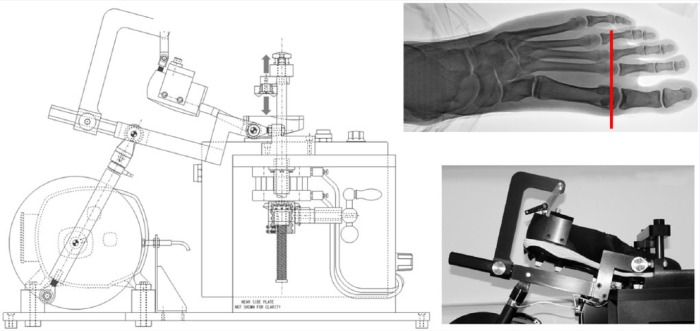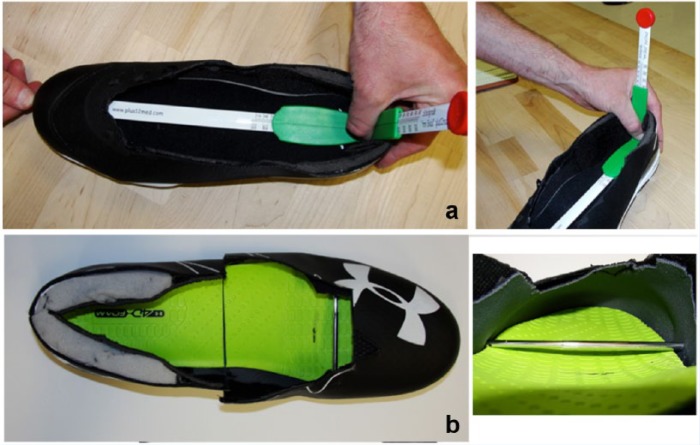Abstract
Background:
Foot and ankle injuries are common in sports, particularly in cleated athletes. Traditionally, the athletic shoe has not been regarded as a piece of protective equipment but rather as a part of the uniform, with a primary focus on performance and subjective feedback measures of comfort. Changes in turf and shoe design have poorly understood implications on the health and safety of players.
Evidence Acquisition:
A literature search of the MEDLINE and PubMed databases was conducted. Keywords included athletic shoewear, cleated shoe, football shoes, and shoewear, and search parameters were between the years 2000 and 2016.
Study Design:
Clinical review.
Level of Evidence:
Level 5.
Results:
The athletic shoe is an important piece of protective sports equipment. There are several important structural considerations of shoe design, including biomechanical compliance, cleat and turf interaction, and shoe sizing/fit, that affect the way an athlete engages with the playing surface and carry important potential implications regarding player safety if not understood and addressed.
Conclusion:
Athletic footwear should be considered an integral piece of protective equipment rather than simply an extension of the uniform apparel. More research is needed to define optimal shoe sizing, the effect that design has on mechanical load, and how cleat properties, including pattern and structure, interact with the variety of playing surfaces.
Keywords: athletic shoewear, footwear, cleated shoe
In recent years, there has been increasing focus on injury prevention in sports, particularly American football. Research has evolved and now considers how protective equipment relates to athletic injury and how that protective equipment should be designed, appropriately fit, and properly utilized. The commonly acknowledged pieces of protective equipment include the helmet, shoulder pads, neck collars, ankle bracing or taping/spatting, knee bracing, and even mouth guards.2,12,21,22,26,30 While shoe design has sought to improve athlete performance by improving shoe-turf interaction and minimizing the mass of the shoe, little attention within the current and historical literature has been given to the effect that athletic footwear has on player safety, including injury prevention, particularly in cleated athletes. If biomechanical or epidemiologic evidence exists that suggests athletic footwear should be considered a piece of protective equipment, then further questions on the design, fit, and use may be considered in the context of injury prevention. The aim of this review is to report the published literature on the relationship between an athlete’s foot, shoe, and the playing surface and the shoe’s role as a piece of protective equipment affecting both performance and injury risk.
Injury Risk
American football is a physical sport that involves high-impact activities between powerful players. The injury rate in American football is high, with up to 28% of players sustaining some type of injury per year.7 From an exposure risk perspective, the risk of injury in football is thought to be around 35.9 injuries per 1000 exposures, such as a practice or a game. This is the highest of 15 collegiate sports studied.15 Injury rates for the foot or ankle in particular are thought to be about 15 per 10,000 exposures.19 Furthermore, injuries not directly to the foot or ankle can still be related to the interaction between the shoe and the ground; this is most easily evidenced by the rate of noncontact injuries in all sports.3,8,17 For these reasons, injury prevention is of particular interest in American football.
Shoe Plate Stiffness
Bending stiffness of a shoe is an important consideration when choosing a shoe design. Hyperdorsiflexion of the midfoot and forefoot is a common cause of disability and lost playing time in sports. Rodeo et al28 found that 45% of professional football players sustain a hyperdorsiflexion injury to the first metatarsophalangeal (MTP) joint (ie, “turf toe injury”) at some point in their career (Figure 1). In the classic study by Bojsen-Møller,4 it was noted that there are 2 potential flexion axes at the level of the MTP joint. The first of these is a transverse axis through the first and second metatarsal heads, and the second is an oblique axis extending from the second to the fifth metatarsal head. Bojsen-Møller4 referred to these as the “high gear” and “low gear” axes, respectively (Figure 2). The high gear axis is the functional axis of rotation during high-intensity athletic movements and is of particular interest because it is also the axis that is associated with a hyperdorsiflexion mechanism of turf toe injury to the first MTP joint.6 This concept is supported by Frimenko et al10 in their observation that the risk of turf toe injury increases as the amount of first MTP joint dorsiflexion increases. Considering this, injury risk may potentially be decreased by increasing the stiffness of the shoe plate. The concern, however, is that this increase in stiffness may occur at the expense of decreasing the ability of the athlete to achieve the high levels of dorsiflexion necessary for football play. Therefore, assessment of the functional range of motion of the first MTP joint required for performance in these athletes must be clearly defined and understood to differentiate between the required functional spectrum necessary for play and pathologic excess of motion at the first MTP joint that leads to injury.
Figure 1.
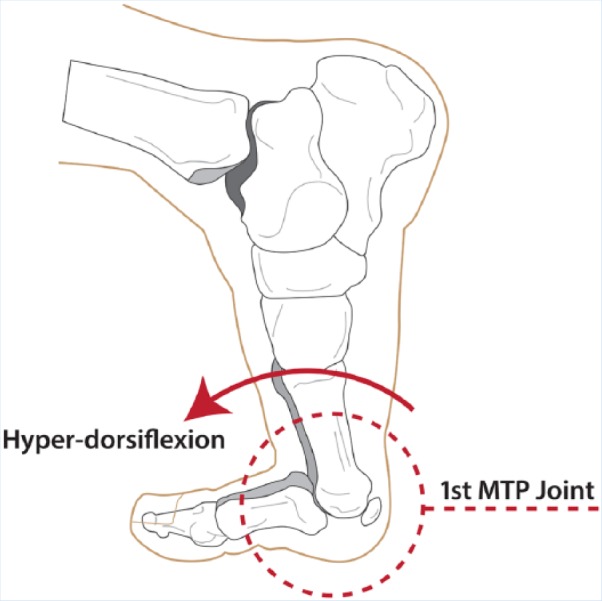
Mechanism of injury to the first metatarsophalangeal (MTP) joint is a hyperdorsiflexion injury.
Figure 2.
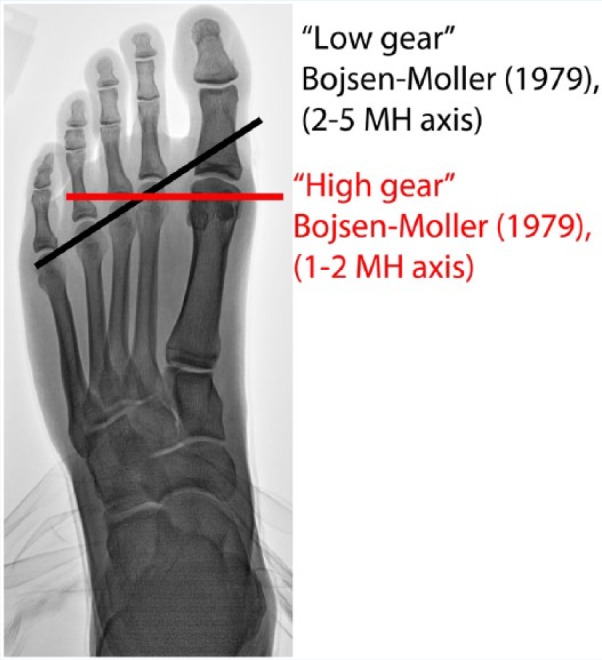
Performance axis of rotation about the metatarsophalangeal joints, as described by Bojsen-Møller.4
Historically, the fundamental idea of shoe plate design has been that shoes should be flexible and compliant with the various demands of athletes in their particular sport.9 The concept of how bending stiffness affects the performance range of motion has been the topic of study in multiple publications.1,9,24,29,31 In their study on forefoot requirements in football-related play, Riley et al27 demonstrated that the maximum dorsiflexion angle about the first metatarsophalangeal joint during football-specific activities remained less than 60° in 9 elite-level athletes performing a variety of movements.27 In this study, running required the greatest amount of dorsiflexion motion.27 The effect that shoe plate stiffness has on performance is not well understood; at least 1 study has shown that performance may in fact increase with increasing stiffness of the shoe.32 In this study, Stefanyshyn and Nigg32 found that increasing the stiffness of the MTP joint reduced the amount of lost energy and resulted in an improvement in performance. A recent study by Takahashi et al33 countered that finding, however, demonstrating that whole-body metabolic cost is increased with increased foot stiffness, likely due to a decrease in the mechanical advantage of the plantar flexors. The latter of these studies highlights an important point: Loads passing through the foot and ankle onto the rest of the lower extremity are affected by the traversing tendons and proximal muscles, whose moment arms are changed by stiffening the foot and thus decreasing the normal motion of the joints of the foot. As such, this effect is not fully understood in the context of performance or injury spectrums.
Quantifying bending stiffness of currently utilized cleats is an important exercise for a few reasons. First and foremost, it allows an assessment of current shoes worn by American football athletes and provides players, coaches, and medical staff an objective measure by which to gauge shoe selection other than by subjective feel, particularly in consideration of treatment of recent or remote midfoot/forefoot injury. Furthermore, it provides a baseline definition of shoewear characteristics to allow further exposure analysis of injuries specifically thought to be related to pathologic movements/moments of the foot (eg, Lisfranc, turf toe). To this end, Crandall et al6 developed a methodology for testing the bending stiffness of cleated American football shoes that was expanded on by Lessley et al18 in a landmark study on the bending stiffness of available American football cleats. The concept, based on work by Parham et al25 in 1992, notes that the high gear axis is located at approximately 70% of the way along the inside length of the shoe, which can then be used as a landmark for flexion testing. They then performed flexion tests to determine stiffness of 30 different US size 12 American football cleats (Figure 3). They found that the stiffness of the shoes showed great variability, ranging from 0.3 to 0.8 N·m/deg, and peak torque values ranged from 11.8 to 25.5 N·m. The peak torque in these tests varied by a factor of 2.2, and the range of stiffness varied by a factor of 3.0. This study is clinically useful because it provides a scale by which to compare relative shoe stiffness.
Figure 3.
Experimental test setup schematic as described by Lessley et al18 (left; reprinted with permission from Lessley et al18) and actual setup (below right), which estimates the 1-2 metatarsophalangeal joint axis located at approximately 70% of the inside length (above right).
In guiding future research on this topic, current data support that the shoe plate may have a variable stiffness, with a stiffness designed for performance up to a dorsiflexion angle just shy of injury level flexion angles and increased stiffness above performance levels to reduce injury risk. However, more research is needed to define optimal shoe stiffness and its ultimate effect on foot biomechanics as it relates to injury risk and performance.
Cleat Design
Understanding the relationship between cleat design and applied loads by an athlete is a challenging topic. Shoe size, cleat size, cleat material, and number and distribution of cleats are all highly variable within and among various shoe manufacturers. Cleat placement can have an impact on bending stiffness of the plate as well as comfort and the distribution of contact pressures.
Cleat design can affect the way in which forces are transferred from the shoe onto the turf. There are 2 main types of forces acting on the foot as it interacts with the ground: ground reaction force and rotational torque. Brock et al5 studied the effect that cleat design had on vertical ground reaction force while performing a 180° cut and 90° land and cut activities. They found no difference in peak vertical ground reaction force between a nonstudded running shoe, a natural turf stud, and a synthetic turf stud.5 These results support the previous findings of Griffin et al,13 which ultimately led to the conclusion that peak ground reaction force may not be responsible for differential injury rates between cleats. Instead, they propose the manner in which the cleat interacts with different playing surfaces (translational force and torque) may be at least partially responsible and an area of future research.13
Galbusera et al11 examined cleat design and the impact on internal and external rotational peak torque. They compared metal studs with molded rubber studs and bladed cleats on both natural and artificial turfs and found similar peak torques between designs but a less stiff behavior on natural surface compared with artificial surface, that is, a lower torque for a given angular rotation.11
Wannop et al34 researched design in a slightly different manner by comparing varying sole designs (tread vs smooth) in a traction testing machine and on recreational athletes. They found that translational traction and rotational moments were greater in the treaded group compared with smooth shoes. They also found that peak ankle external rotational moments, knee external rotation moments, knee adduction moments, and knee adduction angular impulse were greater in the treaded group compared with the smooth shoe.34 This study demonstrates that cleat design can be protective in that it can decrease forces acting on the body.
When an athlete accelerates or cuts with a cleat on a playing surface (applies a force or moment), there are 3 possible interactions: (1) the cleat can slide on the surface, (2) the cleat can tear a portion of the surface way (create a divot), or (3) the cleat can hold with minimal movement between the cleat and the surface. Kent et al16 reviewed these possibilities by looking at the mechanical interaction of 19 American football cleats with both a natural grass surface as well as an infill-type artificial surface under loading conditions designed to simulate and capture peak forces and torques observed in elite athletes (Figure 4). They found that all of the cleat designs failed by shear of the natural surface either by sliding across the surface in less aggressive cleat patterns or by generating a divot in the surface after the test. In contrast, when tested on an artificial playing surface, only 1 cleat design “released” from the surface by way of sliding; the rest endured forces and torques to the limit of the testing device. Considering these results, an important observation was made in this study independent of the playing surface variation. When a cleat “releases” either by sliding or by creating a divot, the force-limiting factor is the interface between the cleat and the surface. In the situation where the cleat fails to release, the force-limiting factor is the force applied by the athlete, which in the extreme will result in injury. In other words, in an ideal world where a certain level of force is known to cause injury, a cleat-turf interface may be designed to “release” at such a point that the foot never experiences the injury load level. If an aggressive cleat is worn on artificial turf, the potential exists for the foot to experience extremely high forces and potentially cause injury. This may be responsible for the increased rate of foot, ankle, and knee injuries seen on infill artificial surfaces compared with natural grass.14
Figure 4.
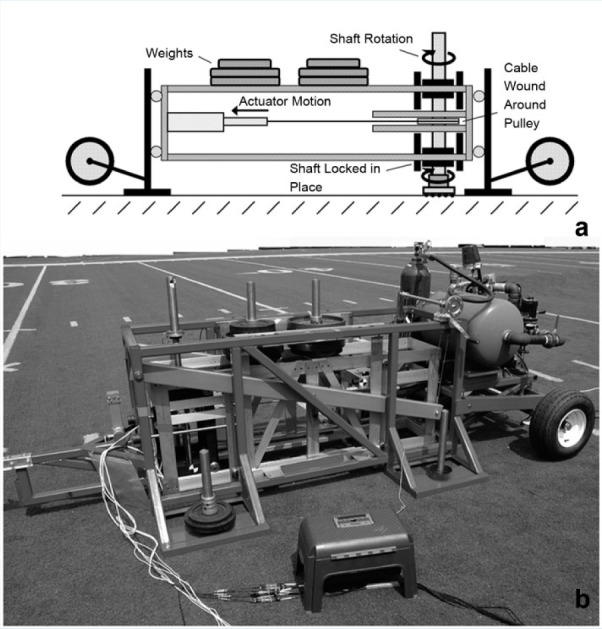
Experimental test setup as described by Kent et al16: (a) schematic and (b) actual setup demonstrating a rotational test between the cleat and field surface.
Shoe Sizing
In selecting an athletic shoe and associated cleat pattern to wear, it is important that the correct size of shoe and shoe plate are selected. Currently, there are devices to help determine shoe size such as the Brannock Device (The Brannock Device Company), but there are many variables in addition to sizing, including compliance of fabric, shoe shape, and so on, as well as no industry-mandated consistency of sizing within or among various manufacturers.
A survey was performed of commercially available US size 12 American football cleated shoes produced in 2016 (Figure 5). The total inside length of the shoe (from the heel to the toe) was measured using the plus12med measurement device (http://www.plus12med.com). The inside width of the shoe was measured across the forefoot using a telescoping rod that extended until it engaged the medial and lateral inside surfaces of the shoe, at a location 70% of the total inside shoe length. The inside shoe length measurement varied from 287 mm to a maximum of 302 mm (Figure 6). Taken in context of reported industry standard differences between shoe sizes (ie, size 11 to size 12), this variability meant some reported size 12 shoes were instead a size 11 or 13 in true measured length. In a similar variable way, measurement of the inner width at 70% along the length axis of the shoe of these same “size 12” shoes ranged from 94 mm to over 106 mm. These findings are important for several reasons. First, if future shoe design is to be intentional with regard to appropriate fit and injury prevention, a standardized relationship between shoe length and associated shoe size is necessary. Second, little is known about the relationship between foot width, shoe width, and injury, but there may be some relationship between foot width and ankle injury.23 In addition, high-risk injuries such as a fifth metatarsal stress fracture could be affected by shoe fit and design.20 For example, if a shoe is too narrow and the fifth metatarsal overhangs, it could be exposed to increased forces. To reliably study this relationship, however, a standardized measurement technique for measuring player foot width to match specific shoe width would help standardize research protocols for the study of shoe width biomechanical effects and has the potential to improve shoe fit. This is a potential area of future injury prevention research. Finally, player safety must be a priority. The lack of standardization within and between manufacturers makes safety recommendations difficult to develop because there are too many confounding factors to consider when comparing the current shoe designs available.
Figure 5.
(a) Inside length measurements used to calculate the 70% of inside length position for (b) width measures taken along the estimated 1-2 metatarsophalangeal joint axis.
Figure 6.
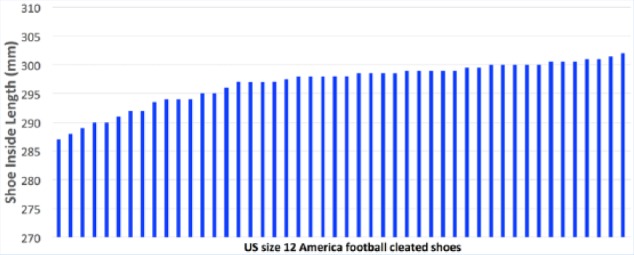
Range of length measurements in rank order of length.
Conclusion
Evidence supports that the athletic shoe has an impact on the athlete beyond that of comfort and appearance. Athletic footwear should be considered an integral piece of athletic equipment rather than simply an extension of the uniform apparel. Evidence is limited, and more research is needed to define optimal shoe sizing, the effect that design has on mechanical load, and how cleat properties including pattern and structure interact with the variety of playing surfaces.
Footnotes
The following authors declared potential conflicts of interest: Richard Kent, PhD, is a paid consultant for the NFL. Jeff Crandall, PhD, is a paid consultant for the NFL and has grants/grants pending from the University of Virginia. David Lessley, PhD, is a paid consultant for Biocore. Robert B. Anderson, MD, is a paid consultant for Wright Medical, DJO, Zimmer Biomet, Amniox, and Arthrex; receives royalties from Wright Medical, Arthrex, and Zimmer Biomet; and had travel paid for and received an honorarium for committee chairman duties that included this project oversight from the NFL.
References
- 1. ASTMF911-85. Standard Test Method for Flexibility of Running Shoes (Withdrawn 2002). West Conshohocken, PA: ASTM International; 1994. [Google Scholar]
- 2. Benson BW, Hamilton GM, Meeuwisse WH, McCrory P, Dvorak J. Is protective equipment useful in preventing concussion? A systematic review of the literature. Br J Sports Med. 2009;43(suppl 1):i56-i67. [DOI] [PubMed] [Google Scholar]
- 3. Boden BP, Sheehan FT, Torg JS, Hewett TE. Noncontact anterior cruciate ligament injuries: mechanisms and risk factors. J Am Acad Orthop Surg. 2010;18:520-527. [DOI] [PMC free article] [PubMed] [Google Scholar]
- 4. Bojsen-Møller F. Calcaneocuboid joint and stability of the longitudinal arch of the foot at high and low gear push off. J Anat. 1979;129(pt 1):165-176. [PMC free article] [PubMed] [Google Scholar]
- 5. Brock E, Zhang S, Milner C, Liu X, Brosnan JT, Sorochan JC. Effects of two football stud configurations on biomechanical characteristics of single-leg landing and cutting movements on infilled synthetic turf. Sports Biomech. 2014;13:362-379. [DOI] [PubMed] [Google Scholar]
- 6. Crandall J, Frederick E, Kent R, Lessley D, Sherwood C. Forefoot bending stiffness of cleated American football shoes. Footwear Sci. 2015;7:139-148. [Google Scholar]
- 7. Dompier TP, Powell JW, Barron MJ, Moore MT. Time-loss and non-time-loss injuries in youth football players. J Athl Train. 2007;42:395-402. [PMC free article] [PubMed] [Google Scholar]
- 8. Drakos MC, Hillstrom H, Voos JE, et al. The effect of the shoe-surface interface in the development of anterior cruciate ligament strain. J Biomech Eng. 2010;132:011003. [DOI] [PubMed] [Google Scholar]
- 9. Frederick EC. The running shoe: dilemmas and dichotomies in design. In: Segesser B, Pförringer W. eds. The Shoe in Sport. Chicago, IL: Yearbook Medical Publishers; 1989:26-35. [Google Scholar]
- 10. Frimenko RE, Lievers WB, Riley PO, et al. Development of an injury risk function for first metatarsophalangeal joint sprains. Med Sci Sports Exerc. 2013;45:2144-2150. [DOI] [PubMed] [Google Scholar]
- 11. Galbusera F, Tornese DZ, Anasetti F, et al. Does soccer cleat design influence the rotational interaction with the playing surface? Sports Biomech. 2013;12:293-301. [DOI] [PubMed] [Google Scholar]
- 12. Gorden JA, Straub SJ, Swanik CB, Swanik KA. Effects of football collars on cervical hyperextension and lateral flexion. J Athl Train. 2003;38:209-215. [PMC free article] [PubMed] [Google Scholar]
- 13. Griffin LY, Agel J, Albohm MJ, et al. Noncontact anterior cruciate ligament injuries: risk factors and prevention strategies. J Am Acad Orthop Surg. 2000;8:141-150. [DOI] [PubMed] [Google Scholar]
- 14. Hershman EB, Anderson R, Bergfeld JA, et al. An analysis of specific lower extremity injury rates on grass and FieldTurf playing surfaces in National Football League Games: 2000-2009 seasons. Am J Sports Med. 2012;40:2200-2205. [DOI] [PubMed] [Google Scholar]
- 15. Hootman JM, Dick R, Agel J. Epidemiology of collegiate injuries for 15 sports: summary and recommendations for injury prevention initiatives. J Athl Train. 2007;42:311-319. [PMC free article] [PubMed] [Google Scholar]
- 16. Kent R, Forman JL, Lessley D, Crandall J. The mechanics of American football cleats on natural grass and infill-type artificial playing surfaces with loads relevant to elite athletes. Sports Biomech. 2015;14:246-257. [DOI] [PubMed] [Google Scholar]
- 17. Lambson RB, Barnhill BS, Higgins RW. Football cleat design and its effect on anterior cruciate ligament injuries. A three-year prospective study. Am J Sports Med. 1996;24:155-159. [DOI] [PubMed] [Google Scholar]
- 18. Lessley DJ, Frederick EC, Kent R, Sherwood C. Quantifying the forefoot bending stiffness of cleated American football shoes using the Football American Shoe Tester (FAST). Footwear Sci. 2016;8:65-74. [Google Scholar]
- 19. Lievers WB, Adamic PF. Incidence and severity of foot and ankle injuries in men’s collegiate American football. Orthop J Sports Med. 2015;3:2325967115581593. [DOI] [PMC free article] [PubMed] [Google Scholar]
- 20. Mayer SW, Joyner PW, Almekinders LC, Parekh SG. Stress fractures of the foot and ankle in athletes. Sports Health. 2014;6:481-491. [DOI] [PMC free article] [PubMed] [Google Scholar]
- 21. McGuine TA, Hetzel S, McCrea M, Brooks MA. Protective equipment and player characteristics associated with the incidence of sport-related concussion in high school football players: a multifactorial prospective study. Am J Sports Med. 2014;42:2470-2478. [DOI] [PMC free article] [PubMed] [Google Scholar]
- 22. McGuine TA, Hetzel S, Wilson J, Brooks A. The effect of lace-up ankle braces on injury rates in high school football players. Am J Sports Med. 2012;40:49-57. [DOI] [PMC free article] [PubMed] [Google Scholar]
- 23. Milgrom C, Shlamkovitch N, Finestone A, et al. Risk factors for lateral ankle sprain: a prospective study among military recruits. Foot Ankle. 1991;12:26-30. [DOI] [PubMed] [Google Scholar]
- 24. Oleson M, Adler D, Goldsmith P. A comparison of forefoot stiffness in running and running shoe bending stiffness. J Biomech. 2005;38:1886-1894. [DOI] [PubMed] [Google Scholar]
- 25. Parham KR, Gordon CC, Bensel CK. Anthropometry of the foot and lower leg of U.S. Army soldiers: Fort Jackson, SC–1985. www.dtic.mil/dtic/tr/fulltext/u2/a261405.pdf. Accessed January 31, 2017.
- 26. Pietrosimone BG, Grindstaff TL, Linens SW, Uczekaj E, Hertel J. A systematic review of prophylactic braces in the prevention of knee ligament injuries in collegiate football players. J Athl Train. 2008;43:409-415. [DOI] [PMC free article] [PubMed] [Google Scholar]
- 27. Riley PO, Kent RW, Dierks TA, Lievers WB, Frimenko RE, Crandall JR. Foot kinematics and loading of professional athletes in American football-specific tasks. Gait Posture. 2013;38:563-569. [DOI] [PubMed] [Google Scholar]
- 28. Rodeo SA, O’Brien S, Warren RF, Barnes R, Wickiewicz TL, Dillingham MF. Turf-toe: an analysis of metatarsophalangeal joint sprains in professional football players. Am J Sports Med. 1990;18:280-285. [DOI] [PubMed] [Google Scholar]
- 29. Roy JP, Stefanyshyn DJ. Shoe midsole longitudinal bending stiffness and running economy, joint energy, and EMG. Med Sci Sports Exerc. 2006;38:562-569. [DOI] [PubMed] [Google Scholar]
- 30. Simon J, Donahue M. Effect of ankle taping or bracing on creating an increased sense of confidence, stability, and reassurance when performing a dynamic-balance task. J Sport Rehabil. 2013;22:229-233. [DOI] [PubMed] [Google Scholar]
- 31. Stefanyshyn DJ, Nigg BM. Energy aspects associated with sport shoes [in German]. Sportverletz Sportschaden. 2000;14:82-89. [DOI] [PubMed] [Google Scholar]
- 32. Stefanyshyn DJ, Nigg BM. Influence of midsole bending stiffness on joint energy and jump height performance. Med Sci Sports Exerc. 2000;32:471-476. [DOI] [PubMed] [Google Scholar]
- 33. Takahashi KZ, Gross MT, van Werkhoven H, Piazza SJ, Sawicki GS. Adding stiffness to the foot modulates soleus force-velocity behaviour during human walking. Sci Rep. 2016;6:29870. [DOI] [PMC free article] [PubMed] [Google Scholar]
- 34. Wannop JW, Worobets JT, Stefanyshyn DJ. Footwear traction and lower extremity joint loading. Am J Sports Med. 2010;38:1221-1228. [DOI] [PubMed] [Google Scholar]



